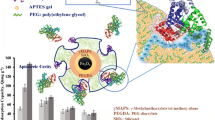Abstract
A sensitive, rapid, and cost-effective method for quantitative analysis of proteins (e.g., detection, purification, depletion) for a wide variety of purposes is required in a number of areas, such as immunodiagnostics and biotechnology. Double-layer imprinting technique, which is carried out via polymerization of polymer solution with higher monomer concentration, covering and filling the supermacroporous structure of a pre-synthesized cryogel column with a lower monomer concentration, thus improving the surface area and adsorption capacity of final product, is a brand new approach for the application of cryogels in molecular imprinting technology. Within the scope of this chapter, BSA is selected as a model protein for the application of double-layer imprinting protocol. In this chapter, synthesis of double-layer BSA-imprinted and non-imprinted cryogel columns (BSA-DLIP and DLNIP, respectively) are described. In addition, characterization of synthesized columns and BSA depletion studies from aqueous solutions are described in detail, as well as selectivity of BSA-DLIPs for BSA, against competitors.
Access this chapter
Tax calculation will be finalised at checkout
Purchases are for personal use only
Similar content being viewed by others
References
Zhang Y, Guo YM, Xian YL, Chen WW, Zhao YY, Jiang XY (2013) Nanomaterials for ultrasensitive protein detection. Adv Mater 25:3802–3819
Mosbach K, Ramström O (1996) The emerging technique of molecular imprinting and its future impact on biotechnology. Nat Biotechnol 14:163–170
Jesus J, Fernandes R, Pessoa G, Raimundo I, Arruda M (2017) Depleting high-abundant and enriching low-abundant proteins in human serum: An evaluation of sample preparation methods using magnetic nanoparticle, chemical depletion and immunoaffinity techniques. Talanta 170:199–209
Schalich KM, Herren AW, Selvaraj V (2020) Analysis of differential strategies to enhance detection of low-abundance proteins in the bovine serum proteome. Anim Sci J 91(1):e13388. https://doi.org/10.1111/asj.13388
Lozinsky V, Galaev I, Plieva F, Savina I, Jungvid H, Mattiasson B (2003) Polymeric cryogels as promising materials of biotechnological interest. Trends Biotechnol 21:445–451
Perçin I, Baydemir G, Ergün B, Denizli A (2013) Macroporous PHEMA-based cryogel discs for bilirubin removal. Artif Cells Nanomed Biotechnol 41(3):172–177
Dainiak M, Plieva F, Galaev I, Hatti-Kaul R, Mattiasson B (2005) Cell chromatography: separation of different microbial cells using IMAC supermacroporous monolithic columns. Biotechnol Prog 21(2):644–649
Kumar A, Srivastava A (2010) Cell separation using cryogel-based affinity chromatography. Nat Protoc 5(11):1737–1747
Sellergren B (2001) Molecularly imprinted polymers: Man-made mimics of antibodies and their applications in analytical chemistry, 1st edn. Elsevier, New York
Martin-Esteban A (2013) Molecularly-imprinted polymers as a versatile, highly selective tool in sample preparation. TrAC Trends Anal Chem 45:169–181
Baydemir G, Denizli A (2015) Heparin removal from human plasma using molecular imprinted cryogels. Artif Cells Nanomed Biotechnol 43:403–412
Okay O, Lozinsky V (2014) Synthesis and structure-property relationships of cryogels. In: Okay O (ed) Polymeric cryogels, advances in polymer science, vol 263. Springer International Publishing, Switzerland, pp 103–157
Ozmen MM, Okay O (2005) Superfast responsive ionic hydrogels with controllable pore size. Polymer 46(19):8119–8127
Bat E (2016) Hydroxyethyl methacrylate-based nanocomposite hydrogels with tunable pore architecture. JOTCSA 3(3):607–622
Ye L, Cormack P, Mosbach K (1999) Molecularly imprinted monodisperse microspheres for competitive radioassay. Anal Commun 36:35–38
Say R, Birlik E, Ersöz A, Yılmaz F, Gedikbey T, Denizli A (2003) Preconcentration of copper on ion-selective imprinted polymer microbeads. Anal Chim Acta 480:251–258
Andac M, Say R, Denizli A (2004) Molecular recognition based cadmium removal from human plasma. J Chromatogr B 811:119–126
Ersöz A, Say R, Denizli A (2004) Nickel(II) ion-imprinted solid phase extraction and preconcentration in aqueous solutions in packed-bed columns. Anal Chim Acta 502:91–97
Daniel S, Babu PEJ, Rao TP (2005) Preconcentrative separation of palladium(II) using palladium(II) ion-imprinted polymer particles formed with different quinoline derivatives and evaluation of binding parameters based on adsorption isotherm models. Talanta 65(2):441–452
Murozuka T, Moriwaka M, Ito H, Sekiguchi S, Naiki M, Tanaka K, Aoyama T, Komuro K (1990) Bovine albumin-like protein in commercial human albumin for clinical use. Vox Sang 59(1):1–5
Balkani S, Shamekhi S, Raoufinia R, Parvan R, Abdolalizadeh J (2016) Purification and characterization of Bovine Serum Albumin using chromatographic method. Adv Pharm Bullet 6(4):651–654
Lindsey BJ (1996) Amino acids and proteins. In: Bishop ML, Duben-Engelkirk JL, Fody EP (eds) Clinical chemistry: principles, techniques, and correlations. J. B. Lippincott Co, Philadelphia, pp 169–214
Fanali G, di Masi A, Trezza V, Marino M, Fasano M, Ascenzi P (2011) Human serum albumin: from bench to bedside. Mol Asp Med 33(3):209–290
Morrisett JD, Pownall HJ, Gotto AM Jr (1975) Bovine serum albumin. Study of the fatty acid and steroid binding sites using spin-labeled lipids. J Biol Chem 250(7):2487–2494
Image of RCSB PDB (rcsb.org) of PDB ID: 4F5S (Bujacz A, Bujacz G (2012) Crystal structure of bovine serum albumin DOI: https://doi.org/10.2210/pdb4f5s/pdb) created with The PyMOL Molecular Graphics System, Version 2.0 Schrödinger, LLC
Author information
Authors and Affiliations
Corresponding author
Editor information
Editors and Affiliations
Rights and permissions
Copyright information
© 2021 The Author(s), under exclusive license to Springer Science+Business Media, LLC, part of Springer Nature
About this protocol
Cite this protocol
Zenger, O., Baydemir Peşint, G. (2021). Synthesis of Double-Layer Imprinted Polymers: BSA Depletion. In: Martín-Esteban, A. (eds) Molecularly Imprinted Polymers. Methods in Molecular Biology, vol 2359. Humana, New York, NY. https://doi.org/10.1007/978-1-0716-1629-1_6
Download citation
DOI: https://doi.org/10.1007/978-1-0716-1629-1_6
Published:
Publisher Name: Humana, New York, NY
Print ISBN: 978-1-0716-1628-4
Online ISBN: 978-1-0716-1629-1
eBook Packages: Springer Protocols




